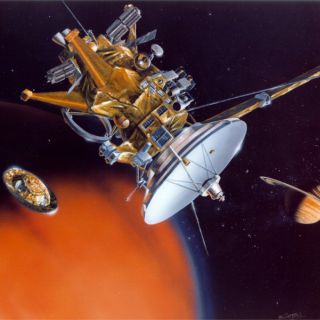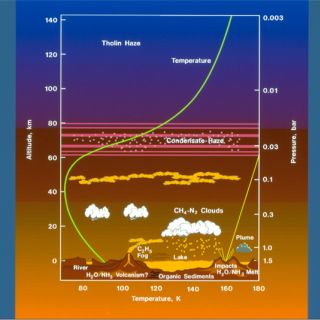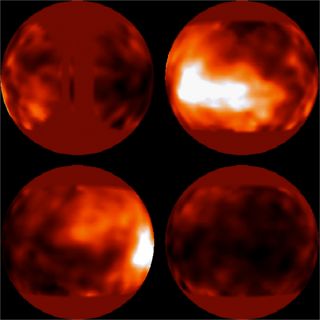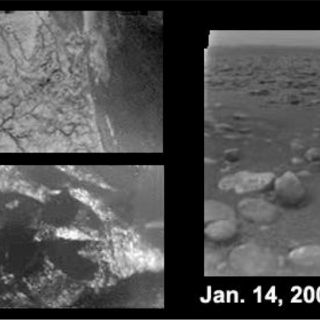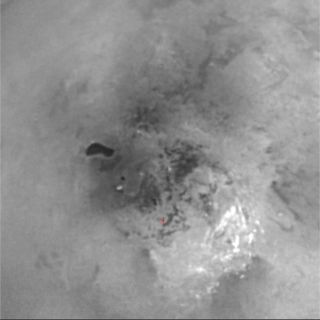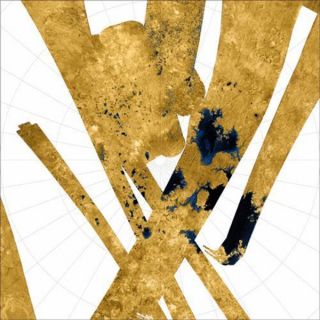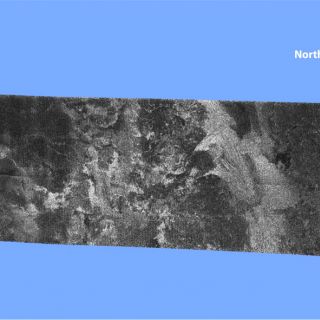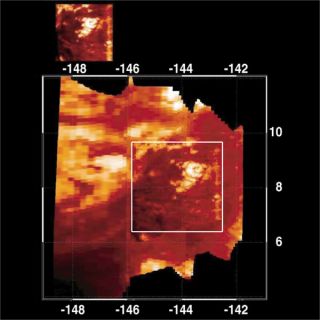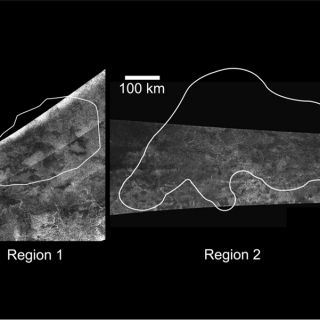Conor Nixon, NASA Goddard Space Flight Center
1. Introduction
Titan has both fascinated and perplexed scientists since its discovery in 1655 by the Dutch astronomer Christiaan Huygens, especially due to its distinct orange coloration and lack of visible surface features. Little progress was made on understanding this satellite until 1944, with the breakthrough discovery of methane gas absorptions by G. P. Kuiper (1944), confirming earlier suspicions of an atmosphere by Josep Comas Sola (1908). Titan was now unique - the only moon in the solar system with a substantial atmosphere - and yet this only added to the mystery, as the depth of the atmosphere and hence the diameter of the body was now unknown. At last in 1979 the Voyager 1 spacecraft flew behind Titan as seen from Earth, and scientists were able to use the occultation of the radio signal to determine where the solid surface began. The answer: a diameter of 5150 km, slightly smaller than Jupiter's moon Ganymede but larger than the planet Mercury (Lindal et al. 1983). In addition, Voyager showed that methane constitutes just 5% of the bulk atmosphere, with molecular nitrogen (N2) making up the remaining 95%.
Voyager however was unable to image the surface: its cameras could not penetrate the haze blanket any more than Earth-based telescopes, and no hoped-for gaps in the veil were seen. To delve deeper, a new mission was planned: the double act of Cassini [Fig. 1], a Saturn-orbiting mother ship, and Huygens, a dedicated Titan atmospheric probe that was also hoped to survive a parachute landing on the surface. Here another of Titan's unending mysteries became an engineering dilemma: what sort of surface would Huygens land on? In the post-Voyager years, models of Titan's chemistry showed that vast quantities of hydrocarbons, especially ethane gas, are being continuously generated in the upper atmosphere (Yung et al. 1984). These percolate down to the lower atmosphere encountering a temperature minimum at 45 km, the tropopause, where they condense and rain out onto the surface [Fig. 2]. Over billions of year of production, the surface could now be covered in oceans of exotic liquids (Flasar 1983; Lunine et al. 1983).
The year is now 2010, and Huygens successfully landed on Titan in January 2005, returning dramatic new insights during its brief mission of a few hours. Cassini has been orbiting Saturn for 6 years, making 70 close flybys of Titan to date, and returned a wealth of information regarding the enigmatic moon, answering some questions but raising many more in their place. The mission has now been extended for a further 7 years and as we stand now at the mid-point of this incredible journey, it is appropriate to both reflect on how far along the road to understanding Titan we have come, and what tasks lie on the road ahead.
In this article I have selected two key scientific mysteries about Titan that Cassini-Huygens was designed to shed light on, and show how the first of these has been mostly solved - although it has raised new questions. Meanwhile the second puzzle initially showed promising signs of a solution as well, but as the mission progressed these first diagnoses were shown to be off the mark, and now the problem stands deeper and more perplexing than ever. In the closing, I will mention other unsolved riddles that may be answered during the remainder of the mission, or may await focused future missions. One thing about Titan is certain: that there will be no shortage of mysteries for a long time to come.
2.1 Wet or dry?
Since the 1970s it had been suggested that methane, and perhaps other organic chemicals detected in Titan's atmosphere would collect on the surface, forming solid or liquid deposits. In the post-Voyager era these ideas firmly took root, and initial studies predicted that the satellite could be covered by a layer of liquid methane or ethane to a mean depth of up to 600m (Flasar 1983; Lunine et al. 1983). However, contrary evidence soon emerged. One problem was Titan's non-zero eccentricity, as the orbit would tend to circularize over geologic time if the tides raised in large, shallow oceans were able to dissipate against landmasses. This reasoning implied that the liquid covering must either be deep and global, or limited to small isolated lakes (Sagan and Dermott 1982). To distinguish between these scenarios, a dedicated effort was made to measure Titan's radar reflectivity, which showed relatively high values incompatible with a deep global ocean (Muhleman et al. 1990).
During the 1990s, a breakthrough technique finally allowed the surface to be imaged at short wavelengths. By exploiting spectral ‘windows' in the near-infrared, where methane gas was transparent, large telescopes equipped with adaptive optics were able to observe a bright ‘continent' on the leading hemisphere, and also to confirm that Titan was indeed synchronously rotating, keeping the same face towards Saturn at all times (Smith et al. 1996; Combes et al. 1997; Meier et al. 2000; Coustenis et al. 2001) [Fig. 3]. Most moons in the solar system are ‘tidally locked' in this way, including the Earth's own Moon. But once again there was no evidence for widespread seas or oceans. The final surprise before Cassini was a second radar experiment, using the giant 305m dish at Arecibo to transmit and receive, that found the tell-tale specular reflection often characteristic of liquid surfaces (similar to the glint of the Sun on the sea) in about 75% of locations (Campbell et al. 2003): a confusing result given the accumulated evidence militating against large bodies of liquid at this point.
This then was the prevailing paradigm prior to the arrival of Cassini-Huygens in 2004: Titan appeared to have a heterogeneous, surprisingly reflective surface, albeit devoid of widespread oceans. Yet tantalizing clues hinted at the existence of localized surface liquids. Now it would be up to Cassini and Huygens to resolve the question conclusively.
The first round went to Huygens, which landed on Titan on January 14th 2005. Images snapped during the descent showed an intriguing landscape, with brighter ‘highlands' apparently threaded by dendritic (branching) networks of channels, and darker lowlands, where Huygens eventually settled, scattered with stream-tossed cobbles of ice like the outwash from a flood [Fig. 4]. Yet no evidence for running rivers or standing lakes, not even a pond, was seen by Huygens. Was Titan then akin to Mars, where a rain-drenched past had given way long ago to dried-up deserts? The answer was not long in coming.
In June that same year, the long-awaited ‘aha' moment arrived. During an un-targeted distant flyby, Cassini obtained the first good view of Titan's south pole, and its imaging cameras spied a striking dark outline in the shape of a titanic footprint 235 km across and 20,000 km2 in area located at 72°S [Fig. 5]. Later observations confirmed the diagnosis, and the feature was later named Ontario Lacus. So perhaps lakes were a polar phenomenon only, where the global circulation might bring hydrocarbon-saturated air to colder climes where condensation and rainfall could occur? Would lakes also be discovered on the opposite pole? Unfortunately, Titan's far north would be shadowed in the long polar night for years to come, so visible-light cameras were temporarily blind.
So it fell to Cassini's synthetic aperture radar (SAR) to discover the biggest wetlands of all: the vast expanses of seas and lakes first recorded during a polar pass in July 2006. These radar-dark features showed almost no backscatter of radio waves to spacecraft, and were compatible only with an interpretation of a smooth liquid surface (Stofan et al. 2007). Later passes revealed the true extent of the ‘lake district': with the largest sea Kraken Mare covering an estimated area of ~200,000 km2, approaching the size of Earth's Caspian Sea [Fig. 6]. The second largest sea, Ligeia Mare, has recently been named the target of a proposed future lake-lander mission, called TiME (short for Titan Mare Explorer).
So at last scientists had determined the extent of surface liquids: lakes and seas of hydrocarbons prevailed on Titan, rather than vast oceans. But the way of science is that each new advance in knowledge brings further questions, and this puzzle was no different. As Cassini enters its solstice mission phase we are left to wonder: how long ago were the floods that created the equatorial drainages? Why the asymmetry in lake coverage between north and south? Theories are already being advanced (e.g. Aharonson et al. 2009) but much work remains to be done before these lingering uncertainties are laid to rest.
2.2 Volcanoes or fissures?
The question of Titan's degree of liquid covering at least was quickly answered by Cassini. A related topic however has proved much more thorny, and no conclusion has yet been reached. The issue concerns Titan's atmospheric methane, and specifically whether the atmosphere is resupplied with this hydrocarbon from the interior, by means of volcanism, tectonic fissuring or other process.
The problem arises due to the continual destruction of methane in Titan's upper atmosphere, by action of sunlight (solar ultraviolet photons) and charged particle impacts originating from Saturn's magnetosphere. These processes are efficient enough that Titan's entire atmospheric methane inventory would vanish in a few tens of millions of years (Yung et al. 1984) - with far-reaching consequences including a decreased greenhouse effect and possible condensation out onto the surface of the entire remaining atmosphere (Lorenz et al. 1997)- unless the methane is somehow being replenished.
The long-serving paradigm has been that methane resupply must be an ongoing process, either continuous or at least episodic. Methane could plausibly have been captured during Titan's formation, and trapped in icy water-molecule cages called clathrates. Later, the primordial mixture of rock and ice would be warmed by natural radioactivity and begin to differentiate, with the rock sinking to form a solid core, while a molten mantle of ammonia-water antifreeze could develop above, capped by an icy crust. Periodic or ongoing destabilizations in the core and crust would result in convection, and perhaps eruptions of cryolava - icy slurry - would bring fresh methane to the surface. Expectations were therefore high that when Cassini finally imaged Titan closely no shortage of volcanic flows would be found.
The initial reports were indeed encouraging. During the first close-up flyby of Titan on October 26th 2004, the Cassini SAR swept across a large, circular feature that was radar-dark, often indicating smooth terrain [Fig. 7]. The geologists on the team thought they recognized a similarity to volcanic structures on another world: the flattened ‘pancake domes' of Venus (Lopes et al. 2007). The feature, named Ganesa Macula at 180 km across was much larger than the Venusian domes (10-30 km) and the height was later estimated at 2-5 km. During the same initial flyby, the VIMS team (Visible and Infrared Mapping Spectrometer) believed that had also struck cold ‘gold'. They had spied a curious fan-like structure, apparently consisting of layered flows and initially dubbed ‘the snail,' later given the more dignified title of Tortola Facula (Sotin et al. 2005) [Fig. 8].
These early enthusiasms were to prove unfounded, and illustrate the need for extreme caution in interpreting two-dimensional images as three-dimensional objects. The end for Ganesa came in 2008 at a meeting of the American Geophysical Society, when Randy Kirk of the Cassini Radar Team unveiled the results of a detailed topographical survey of 2% of Titan's surface. This was achieved by stereogrammetry - using the parallax information contained in two views of the same region from different directions. Ganesa was not a dome: the eastern edge is a mountain ridge - a topographical high - while the western side is a topographical low, and the compelling circular Ganesa feature itself is no more than a trick of the eye trying to impose order on disorder. The myth of Tortola Facula was similarly exploded by the merciless arc of the radar beams: it appeared as an unremarkable expanse of varied terrain with none of the apparent smooth lobes seen by the lower resolution of VIMS.
Yet, the idea of cryovolcanism continues to be compelling, if controversial. The latest salvo in the lava-wars has focused on the areas of Hotei and Tui Regios, where apparent lobate flows seen by radar were interpreted as cryovolcanic in origin (Wall et al. 2009) [Fig. 9], and photometric variability in VIMS near-infrared images was interpreted as ammonia frost in one area (Nelson et al. 2009a) and resurfacing in another (Nelson et al. 2009b). However the variability in at least the first area (Hotei) has been disputed by a later study (Soderblom et al. 2009).
What conclusions can we draw from this debate? Firstly, that interpreting the coarse images obtained through Titan's haze, and even radar maps of Titan surface must be embarked on with extreme caution, preferably armed with knowledge of the topographical dimension from SAR stereogrammetry. Secondly, that Titan's surface is complex, with many processes responsible for its present-day morphology including aeolian, fluvial, tectonic, cryovolcanic and impacts. Regarding cryovolcanism, a consensus seems to have been reached that some flows are indeed volcanic, while others are fluvial deposits: determining which is which is a process that will doubtless be ongoing for the remainder of the mission. Meanwhile, the dream of seeing an unambiguously active volcanic outburst persists.
3. Conclusions
This article has aimed to introduce the reader to the vexing enigmas of Saturn's largest satellite - a world large enough to make a respectable planet, were it to orbit the Sun rather than Saturn. Titan was deemed important enough to deflect Voyager 1 from a course that could have taken it to an encounter with Pluto, instead to sail briefly past Titan for a tantalizing first encounter that answered too few questions (how big?) and left too many (what does the surface look like?)
Cassini in part, and especially Huygens were devised to answer Voyager's legacy of this world, especially concerning the nature of surface, and the connection of the interior, surface and atmosphere. In this regard, Cassini-Huygens has returned a wealth of results, but many of these have served merely to deep the mysteries so far. One topic that has attracted considerable attention is the idea of primitive life existing in the predicted interior ocean (Raulin 2008), or even on the surface using acetylene (C2H2) as a metabolic energy source (Oremland and Voytek, 2008).
Cassini now stands at its mid-point, and has seven more years (mechanical parts permitting) to study this enigmatic world. Many new discoveries will undoubtedly flow in this time, yet when the spacecraft finally departs Titan to plunge boldly into Saturn's clouds and a swift demise, there are sure to be as many remaining questions as answers. The case for a successor mission - or missions - is already building.
'May you live in interesting times' - so goes the apocryphal Chinese curse. But for those of us studying Titan with the powerful instruments on Cassini-Huygens, the undoubted 'interesting times' on this roller-coaster science mission seem fortunate indeed.
4. References
Aharonson O., Hayes A. G., Lunine J. I., Lorenz R. D., Allison M. D., Elachi C. (2009) An asymmetric distribution of lakes on Titan as a possible consequence of orbital forcing. Nature Geosciences 2:851-854.
Campbell D. B., Black G. J., Carter L. M., Ostro S. J. (2003) Radar evidence for liquid surfaces on Titan. Science 302:431-434.
Comas Sola, J., (1908). J. Br. Astron. Assoc. 19:151.
Combes M., Vapillon L., Gendron E., Coustenis A., Lai O., Wittemberg R., Sirdey R. (1997) Spatially Resolved Images of Titan by Means of Adaptive Optics. Icarus 129:482-497.
Coustenis A., Gendron E., Lai O., Veran J.-P., Woillez J., Combes M., Vapillon L., Fusco Th., Mugnier L., Rannou P. (2001) Images of Titan at 1.3 and 1.6 μm with Adaptive Optics at the CFHT.
Flasar F. M. (1983) Oceans on Titan? Science 221:55-57.
Kuiper, G. P., (1944) Titan: A Satellite with an Atmosphere. Astrophys. J. 100:378-
Lindal G. F., Wood G. E., Hotz H. B., Sweetnam D. N., Eshleman V. R., Tyler G. L. (1983) The Atmosphere of Titan: An Analysis of the Voyager 1 Radio Occultation Measurements. Icarus 53:348-363.
Lopes R. M. C., Mitchell K. L., Stofan E. R., Lunine J. I., Lorenz R., Paganelli F., Kirk R. L., Wood C. A., Wall S. D., Robshaw L. E., Fortes A. D., Neish C. D., Radebaugh J., Reffet E., Ostro S. J., Elachi C., Allison M. D., Anderson Y., Boehmer R., Boubin G., Callahan P., Encrenaz P., Flamini E., Francescetti G., Gim Y., Hamilton G., Hensley S., Janssen M. A., Johnson W. T. K., Kelleher K., Muhleman D. O., Ori G., Orosei R., Picardi G., Posa F., Roth L. E., Seu R., Shaffer S., Soderblom L. A., Stiles B., Vetrella S., West R. D., Wye L., Zebker H. A. (2007) Cryovolcanic features on Titan's surface as revealed by the Cassini Titan Radar Mapper. Icarus 186:395-412.
Lorenz R. D., McKay C. P. and Lunine J. I. (1997) Photochemically driven collapse of Titan's atmosphere. Science 275:642-644.
Lunine J. I., Stevenson D. J. and Yung Y. L. (1983) Ethane ocean on Titan. Science 222:1229-1230.
Meier R., Smith B. A., Owen T. C., Terrile R. J. (2000) The Surface of Titan from NICMOS Observations with the Hubble Space Telescope. Icarus 145:462-473.
Muhleman D. O., Grossman A. W., Butler B. J., Slade M. A. (1990) Radar Reflectivity of Titan. Science 248:975-980.
Nelson R. M., Kamp L. W., Matson D. L., Irwin P. G. J., Baines K. H., Boryta M. D., Leader F. E., Jaumann R., Smythe W. D., Sotin C., Clark R. N., Cruikshank D. P., Drossart P., Pearl J. C., Hapke B. W., Lunine J. I., Combes M., Bellucci G., Bibring J.-P., Capaccioni F., Cerroni P., Coradini A., Formisano V., Filacchione G., Langevin R. Y., McCord T. B., Mennella V., Nicholson P. D., Sicardy B. (2009a) Saturn's Titan: Surface change, ammonia and implications for atmospheric and tectonic activity. Icarus 199:429-441.
Nelson R. M., Kamp L. W., Lopes R. M. C., Matson D. L., Kirk R. L., Hapke B. W., Wall S. D., Boryta M. D., Leader F. E., Smythe W. D., Mitchell K. L., Baines K. H., Jaumann R., Sotin C., Clark R. N., Cruikshank D. P., Drossart P., Lunine J. I., Combes M., Bellucci G., Bibring J.-P., Capaccioni F., Cerroni P., Coradini A., Formisano V., Filacchione G., Langevin Y., McCord T. B., Menella V., Nicholson P. D., Sicardy B., Irwin P. G. J., Pearl J. C. (2009b) Photometric changes on Saturn's Titan: Evidence for cryovolcanism. Geophys. Res. Lett. 36:L04202.
Oremland R. S. and Voytek M. A. (2008) Acetylene as fast food: implications for development of life on anoxic primordial Earth and in the outer solar system. Astrobiology 8:45-58.
Raulin F. (2008) Astrobiology and habitability of Titan. Space Science Reviews 135:37-48.
Sagan C. and Dermott S. (1982) The tide in the seas of Titan. Nature 300:731-733.
Smith P. H., Lemmon M. T., Lorenz R. D., Sromovsky L. A., Caldwell J. J., Alison M. D. (1996) Titan's surface, revealed by HST imaging. Icarus 119:336-349.
Soderblom L. A., Brown R. H., Soderblom J. M., Barnes J. W., Kirk R. L., Sotin C., Jaumann R., Mackinnon D. J., Mackowski D. W., Baines K. H., Buratti B. J., Clark R. N., Nicholson P. D. (2009) The geology of Hotei Regio, Titan: Correlation of Cassini VIMS and RADAR. Icarus 204:610-618.
Sotin C., Jaumann R., Buratti B. J., Brown R. H., Clark R. N., Soderblom L. A., Baines K. H., Bellucci G., Bibring J.-P., Capaccione F., Cerroni P., Combes M., Coradini A., Cruikshank D. P., Drossart P., Formisano V., Langevin Y., Matson D. L., McCord T. B., Nelson R. M., Nicholson P. D., Sicardy B., LeMouelic S., Rodriguez S., Stephan K., Scholz C. K. (2005) Release of volatiles from a possible cryovolcano from near-infrared imaging of Titan. Nature 435:786-789.
Stofan E. R., Elachi C., Lunine J. I., Lorenz R. D., Stiles B., Mitchell K. L., Ostro S., Soderblom L., Wood C., Zebker H., Wall S., Janssen M., Kirk R., Lopes R., Paganelli F., Radebaugh J., Wye L., Anderson Y., Allison M., Boehmer R., Callahan P., Encrenaz P., Flamini E., Francescetti G., Gim Y., Hamilton G., Hensley S., Johnson W. T. K., Kelleher K., Muhleman D., Paillou P., Picardi G., Posa F., Roth L., Seu R., Shaffer S., Vetrella S., West R. (2007) The lakes of Titan. Nature 445:61-64.
Wall S. D., Lopes R. M., Stofan E. R., Wood C. A., Radebaugh J. L., Hörst S. M., Stiles B. W., Nelson R. M., Kamp L. W., Janssen M. A., Lorenz R. D., Lunine J. I., Farr T. G., Mitri G., Paillou P., Paganelli F., Mitchell K. L. (2009) Cassini RADAR images at Hotei Arcus and western Xanadu, Titan: Evidence for geologically recent cryovolcanic activity. Geophys. Res. Lett. 36:L04203.
Yung Y. L., Allen M. and Pinto J. P. (1984) Photochemistry of the atmosphere of Titan: Comparison between model and observations. Astrophys. J. Supp. 55:465-506.
5. Figure Captions
Figure 1. Artist's impression of the Huygens probe separating from the Cassini spacecraft on December 25th 2004, above the hazy atmosphere of Titan. (Image credit: NASA/JPL/Caltech).
Figure 2. Schematic view of Titan's atmosphere. (Credit: ESA).
Figure 3. Titan's surface imaged in 1994 by Smith et al. (1996), using the recently upgraded Hubble Space Telescope: Wide Field/Planetary Camera 2 (WFPC2). The four views are spherical projections based on 14 images taken at near-infrared wavelengths (from 0.85 to 1.05 microns) where Titan's atmosphere is semi-transparent: upper left - Saturn-facing hemisphere; upper right - leading hemisphere; lower left anti-Saturn hemisphere; lower right - trailing hemisphere. (Image Credit: UA Lunar and Planetary Laboratory; STScI.)
Figure 4. Images captured by the Descent Imager Spectral Radiometer (DISR) on Huygens, January 14th 2005. Upper left: from altitude 16.2 km, looking down on an apparent channel network draining to a shoreline at the edge of a dark plain. Lower left: view from altitude 8 km. Right: view from the surface. Rounded ice-cobbles are visible - the center cobble is about 4 cm across. (Image credit: ESA/NASA/University of Arizona.)
Figure 5. Cassini's first clear view of a lake: Ontario Lacus (black footprint shape) near Titan's south pole (marked by red cross) snapped by the Imaging Science Subsystem (ISS) on June 6th 2005 from a range of 450,000 km. (Image credit: NASA/JPL/Space Science Institute.)
Figure 6. Cassini Radar composite map of Titan's northern hemisphere from multiple SAR swaths, shown in false color to indicate presumed land (brown) and lakes (blue/black). Latitude circles are at 60, 70 and 80 degrees. The largest completely mapped lake (upper right) is Ligeia Mare, with an area of ~100,00 km2. Kraken Mare (lower right) is only partly mapped, and may be twice as large. (Image credit: NASA/JPL/USGS.)
Figure 7. Radar SAR swath of Titan from first close Titan flyby of Cassini, October 26th 2004. Smoother terrain is darker (less backscatter towards receiver) whilst bright terrain is generally rougher. The large dark circle at the left end of the swath was a putative pancake dome of cryolava, named Ganesa Macula, at 50°N, 87°W. (Credit: NASA/JPL.)
Figure 8. The first suspected cryovolcano on Titan: Tortola Facula captured by Cassini's Visible and Infrared Mapping Spectrometer (VIMS), October 26th 2004. (Credit: NASA/JPL/University of Arizona.)
Figure 9. Cassini Radar images of two regions on Titan thought to show evidence for cryovolcanic flows. Region 1 is north of Hotei Arcus, about 400 km across and centered on 28°S, 78°W. Region 2 is western Xanadu at 7°S, 135°W and 900 km across.(Image credit: NASA/JPL.)
